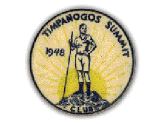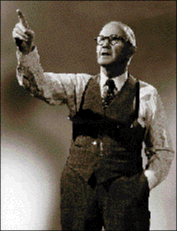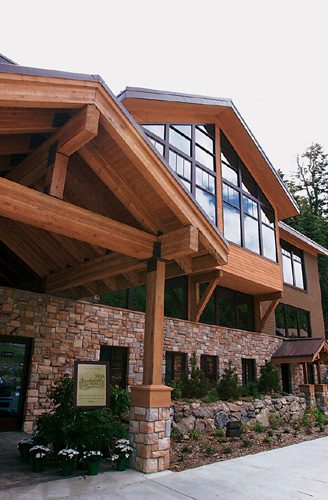In July 1935, a 25-year-old rancher from Thistle, Utah, persuaded his fiancée to accompany him on the Timpanogos Hike. For Alfred Pace and Phyllis Thorsen, who would be married just three months later, that trip started a lifelong relationship with Utah County’s “Stone Sentinel.”
“We loved to go up there and camp,” says Phyllis Pace, now an 82-year-old Provo resident. “We lived for it. That was our annual dream.”
Like many who participated in the Timpanogos Hike between 1912 and 1971, the Paces did more than just ascend the 11,750-foot mountain. For them, it was a two-day campout complete with a spectacular nighttime program. Also like most participants, the Paces wouldn’t even consider hiking Mt. Timpanogos on any day other than the one set aside for the official hike. But unlike most, Alfred Pace participated in every Timpanogos Hike from 1930 to 1971.
 “He just loved Timpanogos,” Phyllis says of her husband, who died in 1994. “He wouldn’t even wait for others–he had to get right up to the top.”
“He just loved Timpanogos,” Phyllis says of her husband, who died in 1994. “He wouldn’t even wait for others–he had to get right up to the top.”
Alfred and Phyllis–along with 4,445 others in 929 automobiles–drove from Utah Valley to Provo Canyon’s Aspen Grove on the cloudy Friday afternoon of July 19, 1935, for the annual celebration started by BYU coach Eugene L. Roberts in 1912. “They had a huge bonfire and a beautiful program,” Phyllis recalls. “We loved that.”
 The couple joined in singing “Timpanogos, Mighty Timpanogos” and witnessed a pageant featuring tap dancing, yodelers, musicians, and the acting out of a Timpanogos legend.
The couple joined in singing “Timpanogos, Mighty Timpanogos” and witnessed a pageant featuring tap dancing, yodelers, musicians, and the acting out of a Timpanogos legend.
“It was cloudy throughout the program and it rained later, but no one cared much,” wrote reporter J.R. Paulson in the July 21, 1935, edition of Provo’s Sunday Herald. “Adequate lights illuminated the performers during the program and the deep shadows of tall trees that surround the clearing lent a mystic air to the setting.”
 Alfred and Phyllis watched as legendary Utah race car driver Ab Jenkins received a Timp Stick, a coveted award for special merit. Others receiving sticks that night included a Long Island, NY, man (farthest distance traveled), a 5-year-old Orem girl (youngest to reach the summit in 1934), and an 89-year-old Roosevelt man (oldest person present). By the time the bonfire was lit and they were ready to begin scaling Timpanogos at midnight, the group was supercharged and didn’t mind losing a night’s sleep to dodge rocks and duck under waterfalls.
Alfred and Phyllis watched as legendary Utah race car driver Ab Jenkins received a Timp Stick, a coveted award for special merit. Others receiving sticks that night included a Long Island, NY, man (farthest distance traveled), a 5-year-old Orem girl (youngest to reach the summit in 1934), and an 89-year-old Roosevelt man (oldest person present). By the time the bonfire was lit and they were ready to begin scaling Timpanogos at midnight, the group was supercharged and didn’t mind losing a night’s sleep to dodge rocks and duck under waterfalls.
By Saturday morning, the sky had cleared and Alfred and Phyllis had reached Emerald Lake. They were ready for the final assault on the summit, including a slippery ascent of the steep snowfield on Timp’s northeast side. “We had to climb clear up to the top of the glacier,” Phyllis says. “Alfred took a hold of my hand and said he’d help me, but we slipped and fell all the way to the bottom. Then we had to climb all the way back up again. I was ready to kill him.”
Eventually, they and 833 others reached the top and received the prized badges that signified their member-ship in the Timp Summit Club. Alfred already had five badges, and he would receive 35 more before the hike was discontinued. The rancher-turned-lineman for Provo City Power is believed to be the only person who received a complete set of badges. Although Roberts started the hike in 1912, badges weren’t awarded until 1930. Phyllis would receive just two more badges, but she never missed a year of camping at Aspen Grove to see the bonfire program and send her husband and children off on the hike. All 11 of the Paces’ children (as well as the family dog) reached the summit at least once, and a couple of them did it as many as 20 times.
Festivities surrounding the Timpanogos Hike evolved over the years. In 1941 hikers raced down the snowfield in the Summer Ski Classic, and a photography contest was started in 1950. The number of hikers who reached the top increased steadily, peaking at 3,500 in 1970. By that year, the number of hikers had grown so large that BYU and the U.S. Forest Service discontinued the hike, although those who made it on their own in 1971 did receive Timp badges.
After Alfred Pace died four years ago, his family noted his love for Timpanogos by having an outline of the mountain carved on his headstone at the Provo City Cemetery. Several months later, a microburst blew down some large trees north of Alfred’s grave, providing a clear view of Mt. Timpanogos.
“One of his friends,” Phyllis says, “told us, ‘Those trees moved so Alfred would have a better view of Timpanogos.'”










